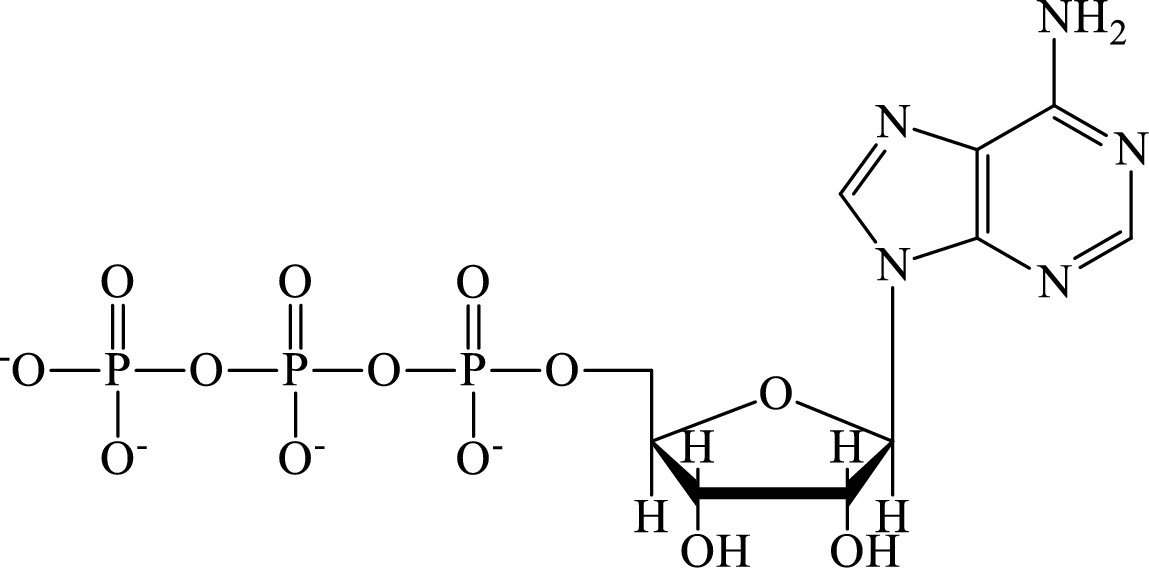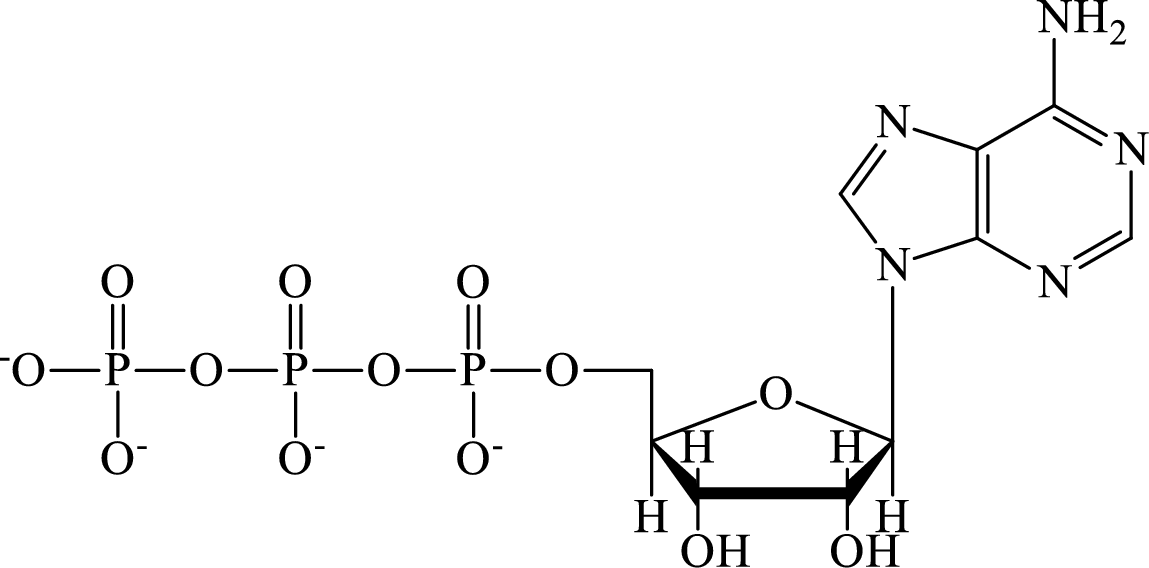
EBK ORGANIC AND BIOLOGICAL CHEMISTRY
7th Edition
ISBN: 9780100547742
Author: STOKER
Publisher: YUZU
expand_more
expand_more
format_list_bulleted
Concept explainers
Question
Chapter 12, Problem 12.116EP
(a)
Interpretation Introduction
Interpretation: To determine the reactants in oxidative phosphorylation.
Concept introduction: Oxidative phosphorylation is the biochemical process for the synthesis of ATP from ADP and
The structure of ATP is:

(b)
Interpretation Introduction
Interpretation: To determine the products in oxidative phosphorylation.
Concept introduction: Oxidative phosphorylation is the biochemical process for the synthesis of ATP from ADP and
The structure of ATP is:

Expert Solution & Answer
Want to see the full answer?
Check out a sample textbook solution
Students have asked these similar questions
1. Determine the relationship between the following molecules as identical, diastereomers, or enantiomers (6
points, 2 points each).
OH
OH
OH
A-A
OH
HOT
HO-
ACHN
and
HO-
ACHN
OH
HO
HO
°
OH
and
OH
OH
SH
and
...SH
20,0
Complete the electron pushing mechanism to
y drawing the necomery unicaciones and carved on for
Step 1: Add curved arms for the tint step, traiment with NalilĻ. The Nation
458
Step 2: Added for the second step, inalment with), how the "counterion
bar
Step 3: Daw the products of the last simplom organic and one incoganic spacient, including all nonbonding
please provide the structure for this problem, thank you!
Chapter 12 Solutions
EBK ORGANIC AND BIOLOGICAL CHEMISTRY
Ch. 12.1 - Prob. 1QQCh. 12.1 - Prob. 2QQCh. 12.2 - Which of the following is not found within the...Ch. 12.2 - Which of the following is not an organelle? a....Ch. 12.2 - Prob. 3QQCh. 12.2 - Which of the following statements about...Ch. 12.3 - Prob. 1QQCh. 12.3 - Prob. 2QQCh. 12.3 - Which of the following statements concerning...Ch. 12.3 - Which of the following statements concerning...
Ch. 12.3 - Which of the following statements concerning...Ch. 12.4 - Prob. 1QQCh. 12.4 - Prob. 2QQCh. 12.5 - Prob. 1QQCh. 12.5 - Prob. 2QQCh. 12.5 - Prob. 3QQCh. 12.6 - Which of the following occurs in the second stage...Ch. 12.6 - Which of the following stages in the biochemical...Ch. 12.6 - Prob. 3QQCh. 12.7 - Prob. 1QQCh. 12.7 - Prob. 2QQCh. 12.7 - Prob. 3QQCh. 12.7 - How many NADH and FADH2 molecules are produced,...Ch. 12.7 - Which of the following citric acid cycle...Ch. 12.7 - In which of the following listings of citric acid...Ch. 12.8 - Which of the following is a fuel for the electron...Ch. 12.8 - Which of the following is a mobile electron...Ch. 12.8 - What is the substrate that initially interacts...Ch. 12.8 - The number of fixed enzyme sites in the electron...Ch. 12.8 - Prob. 5QQCh. 12.8 - In which step in the electron transport chain does...Ch. 12.9 - Prob. 1QQCh. 12.9 - Prob. 2QQCh. 12.9 - Prob. 3QQCh. 12.10 - Prob. 1QQCh. 12.10 - Prob. 2QQCh. 12.11 - Prob. 1QQCh. 12.11 - Prob. 2QQCh. 12.11 - Prob. 3QQCh. 12.12 - How many different B vitamins participate in the...Ch. 12.12 - Prob. 2QQCh. 12 - Classify anabolism and catabolism as synthetic or...Ch. 12 - Classify anabolism and catabolism as...Ch. 12 - What is a metabolic pathway?Ch. 12 - Prob. 12.4EPCh. 12 - Classify each of the following processes as...Ch. 12 - Prob. 12.6EPCh. 12 - Prob. 12.7EPCh. 12 - Prob. 12.8EPCh. 12 - Prob. 12.9EPCh. 12 - Indicate whether each of the following statements...Ch. 12 - Prob. 12.11EPCh. 12 - Prob. 12.12EPCh. 12 - Prob. 12.13EPCh. 12 - Prob. 12.14EPCh. 12 - Prob. 12.15EPCh. 12 - Prob. 12.16EPCh. 12 - Prob. 12.17EPCh. 12 - Prob. 12.18EPCh. 12 - Prob. 12.19EPCh. 12 - Prob. 12.20EPCh. 12 - Prob. 12.21EPCh. 12 - Prob. 12.22EPCh. 12 - Prob. 12.23EPCh. 12 - Write a generalized chemical equation, containing...Ch. 12 - Prob. 12.25EPCh. 12 - Prob. 12.26EPCh. 12 - Prob. 12.27EPCh. 12 - Prob. 12.28EPCh. 12 - Prob. 12.29EPCh. 12 - Prob. 12.30EPCh. 12 - Prob. 12.31EPCh. 12 - Prob. 12.32EPCh. 12 - Prob. 12.33EPCh. 12 - Prob. 12.34EPCh. 12 - What identical structural subunits do the...Ch. 12 - Prob. 12.36EPCh. 12 - Prob. 12.37EPCh. 12 - Prob. 12.38EPCh. 12 - Prob. 12.39EPCh. 12 - Prob. 12.40EPCh. 12 - Prob. 12.41EPCh. 12 - Prob. 12.42EPCh. 12 - Classify each of the following molecules as (1) an...Ch. 12 - Prob. 12.44EPCh. 12 - Prob. 12.45EPCh. 12 - Prob. 12.46EPCh. 12 - Prob. 12.47EPCh. 12 - Prob. 12.48EPCh. 12 - Prob. 12.49EPCh. 12 - Prob. 12.50EPCh. 12 - Prob. 12.51EPCh. 12 - Prob. 12.52EPCh. 12 - Prob. 12.53EPCh. 12 - Prob. 12.54EPCh. 12 - Prob. 12.55EPCh. 12 - Prob. 12.56EPCh. 12 - Prob. 12.57EPCh. 12 - Prob. 12.58EPCh. 12 - List, by name, the four general stages of the...Ch. 12 - Which, by name, of the four general stages of the...Ch. 12 - Prob. 12.61EPCh. 12 - Prob. 12.62EPCh. 12 - Prob. 12.63EPCh. 12 - Prob. 12.64EPCh. 12 - Prob. 12.65EPCh. 12 - Prob. 12.66EPCh. 12 - Prob. 12.67EPCh. 12 - Prob. 12.68EPCh. 12 - Prob. 12.69EPCh. 12 - Prob. 12.70EPCh. 12 - Prob. 12.71EPCh. 12 - Prob. 12.72EPCh. 12 - Prob. 12.73EPCh. 12 - Prob. 12.74EPCh. 12 - Prob. 12.75EPCh. 12 - Prob. 12.76EPCh. 12 - Prob. 12.77EPCh. 12 - Prob. 12.78EPCh. 12 - Prob. 12.79EPCh. 12 - Prob. 12.80EPCh. 12 - Prob. 12.81EPCh. 12 - Prob. 12.82EPCh. 12 - Prob. 12.83EPCh. 12 - Prob. 12.84EPCh. 12 - Prob. 12.85EPCh. 12 - Prob. 12.86EPCh. 12 - Prob. 12.87EPCh. 12 - Prob. 12.88EPCh. 12 - Prob. 12.89EPCh. 12 - Indicate whether each of the following changes...Ch. 12 - Prob. 12.91EPCh. 12 - Prob. 12.92EPCh. 12 - Prob. 12.93EPCh. 12 - Prob. 12.94EPCh. 12 - Prob. 12.95EPCh. 12 - Prob. 12.96EPCh. 12 - Prob. 12.97EPCh. 12 - Prob. 12.98EPCh. 12 - Prob. 12.99EPCh. 12 - Prob. 12.100EPCh. 12 - Prob. 12.101EPCh. 12 - Prob. 12.102EPCh. 12 - Prob. 12.103EPCh. 12 - Prob. 12.104EPCh. 12 - Prob. 12.105EPCh. 12 - Prob. 12.106EPCh. 12 - Prob. 12.107EPCh. 12 - Prob. 12.108EPCh. 12 - Prob. 12.109EPCh. 12 - Prob. 12.110EPCh. 12 - Prob. 12.111EPCh. 12 - Prob. 12.112EPCh. 12 - Prob. 12.113EPCh. 12 - Prob. 12.114EPCh. 12 - Prob. 12.115EPCh. 12 - Prob. 12.116EPCh. 12 - Prob. 12.117EPCh. 12 - Prob. 12.118EPCh. 12 - Prob. 12.119EPCh. 12 - Prob. 12.120EPCh. 12 - Prob. 12.121EPCh. 12 - Prob. 12.122EPCh. 12 - Prob. 12.123EPCh. 12 - Prob. 12.124EPCh. 12 - Prob. 12.125EPCh. 12 - Prob. 12.126EPCh. 12 - Prob. 12.127EPCh. 12 - Prob. 12.128EPCh. 12 - Indicate whether or not each of the following B...Ch. 12 - Prob. 12.130EPCh. 12 - Prob. 12.131EPCh. 12 - Prob. 12.132EP
Knowledge Booster
Learn more about
Need a deep-dive on the concept behind this application? Look no further. Learn more about this topic, chemistry and related others by exploring similar questions and additional content below.Similar questions
- Draw the Fischer projection from the skeletal structure shown below. HO OH OH OH OH H Q Drawing Atoms, Bonds and Rings Charges I ☐ T HO H H OH HO I CH2OH H OH Drag H OH -CH2OH CHO -COOH Undo Reset Remove Donearrow_forwardplease provide the structure for this problem, thank youarrow_forwardpresented by Morallen Lig Intermine the hand product for the given mution by adding atoms, bonds, nonhonding diarion panda скуль Step 3: Comp the draw the product Step 2: Agama workup Compithe 429 ملولةarrow_forward
- Reaction A 0,0arrow_forwardpresented by Morillon Leaning Predict the organic product for the min кусур HSC Adithane carved arnown to come than that to the condon slchroruis in acid in in aquishri with ноюarrow_forward6.15PM Sun Mar 30 K Draw the major product of this reaction. Include any relevant stereochemistry. Ignore inorganic byproducts. Problem 1 of O H [PhзPCH2CH3]*C|¯ NaH Drawing > Q Atoms, Bonds and Draw or tap a nearrow_forward
- 8:17 PM Sun Mar 30 Draw the major product of this reaction. Ignore inorganic byproducts. HSCH2CH2CH2SH, BF3 Probler Drawing Ato Bonds Clarrow_forwardpresented by Mr L How the coprion. (Il Done in no wraction, dew the starting redential) доarrow_forward8:16 PM Sun Mar 30 K Draw the major product of this reaction. Ignore inorganic byproducts. Proble 1. CH3MgBr 2. H3O+ F Drawingarrow_forward
- о но оarrow_forwardName the major organic product of the following action of 4-chloro-4-methyl-1-pentanol in neutral pollution 10+ Now the product. The product has a molecular formula f b. In a singly hain, the starting, material again converts into a secule with the molecular kormula CIO. but with comply Draw the major organic structure inhalationarrow_forwardMacmillan Learning Alcohols can be oxidized by chromic acid derivatives. One such reagent is pyridinium chlorochromate, (C,H,NH*)(CICTO3), commonly known as PCC. Draw the proposed (neutral) intermediate and the organic product in the oxidation of 1-butanol by PCC when carried out in an anhydrous solvent such as CH₂C₁₂. PCC Intermediate OH CH2Cl2 Draw the intermediate. Select Draw Templates More с H Cr о Product Draw the product. Erase Select Draw Templates More H о Erasearrow_forward
arrow_back_ios
SEE MORE QUESTIONS
arrow_forward_ios
Recommended textbooks for you
 General, Organic, and Biological ChemistryChemistryISBN:9781285853918Author:H. Stephen StokerPublisher:Cengage Learning
General, Organic, and Biological ChemistryChemistryISBN:9781285853918Author:H. Stephen StokerPublisher:Cengage Learning Organic And Biological ChemistryChemistryISBN:9781305081079Author:STOKER, H. Stephen (howard Stephen)Publisher:Cengage Learning,
Organic And Biological ChemistryChemistryISBN:9781305081079Author:STOKER, H. Stephen (howard Stephen)Publisher:Cengage Learning, Chemistry for Today: General, Organic, and Bioche...ChemistryISBN:9781305960060Author:Spencer L. Seager, Michael R. Slabaugh, Maren S. HansenPublisher:Cengage Learning
Chemistry for Today: General, Organic, and Bioche...ChemistryISBN:9781305960060Author:Spencer L. Seager, Michael R. Slabaugh, Maren S. HansenPublisher:Cengage Learning

General, Organic, and Biological Chemistry
Chemistry
ISBN:9781285853918
Author:H. Stephen Stoker
Publisher:Cengage Learning

Organic And Biological Chemistry
Chemistry
ISBN:9781305081079
Author:STOKER, H. Stephen (howard Stephen)
Publisher:Cengage Learning,

Chemistry for Today: General, Organic, and Bioche...
Chemistry
ISBN:9781305960060
Author:Spencer L. Seager, Michael R. Slabaugh, Maren S. Hansen
Publisher:Cengage Learning
